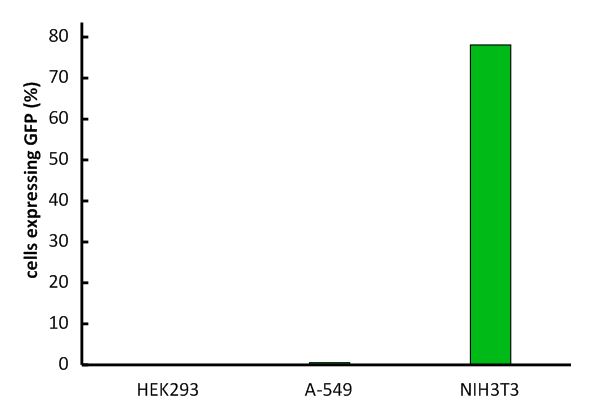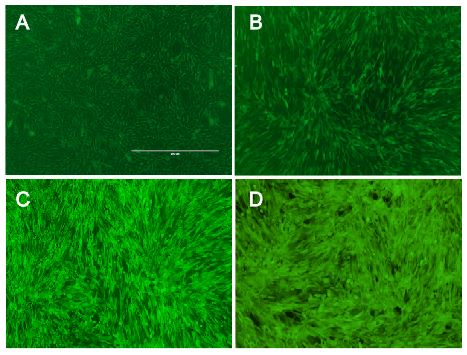Team:Freiburg/Content/Results/Vector
From 2014.igem.org
Mirja Harms (Talk | contribs) |
Mirja Harms (Talk | contribs) |
||
| Line 10: | Line 10: | ||
<div class="row category-row"> | <div class="row category-row"> | ||
<div class="col-sm-6"> | <div class="col-sm-6"> | ||
| - | <p>Our system provides a possibility to stable transfer genes into the genome of cells in spacial and temporal resolution. This transfer is carried out by | + | <p> |
| + | |||
| + | Our system provides a possibility to stable transfer genes into the genome of cells in spacial and temporal resolution. This transfer is carried out by | ||
a vector derived from a murine leukemia virus. Since the vector is one essential part of the system its characterisation is important. The virus is specific | a vector derived from a murine leukemia virus. Since the vector is one essential part of the system its characterisation is important. The virus is specific | ||
for a receptor that is only expressed in mouse cells. For the purpose of our system, this specificity offers the opportunity for targeting only these cells | for a receptor that is only expressed in mouse cells. For the purpose of our system, this specificity offers the opportunity for targeting only these cells | ||
| Line 87: | Line 89: | ||
<h2>1.2 Optimization of transduction</h2> | <h2>1.2 Optimization of transduction</h2> | ||
| - | + | das verhältnis von | |
<div class="row category-row"> | <div class="row category-row"> | ||
<div class="col-sm-6"> | <div class="col-sm-6"> | ||
| - | <p> | + | <p> |
| - | almost 100% efficiency | + | |
| - | + | Making our whole system work the infection efficiency of the viral vector was raised. Therefore, we tried to optimize protocols for viral | |
| + | production and for transduction of target cells. Phoenix cells, our producer cell line, was split several times before usage to make sure | ||
| + | to have them healthy and in an exponential growth phase during the production of viral particles. In addition, supernatant containing the vector | ||
| + | were harvest at distinct time points optimized for optimal viral titer. Target cells were infected by viral supernatant with Polybrene that raises | ||
| + | the probability for particle to reach their target cells. Since murine leukemia viruses only infect dividing cells, growth phases of target cells | ||
| + | were adapted to infection. Last of all, the proportion of viral supernatant to growth medium during infection was optimized to ensure exponential | ||
| + | growth and health of target cells. | ||
| + | Considering all these aspects we, the iGEM team Freiburg 2014 ,reached almost 100% efficiency by infecting murine cell lines with our viral vector. | ||
| + | Since we had only 16% efficiency in transferring genes with the vector at the beginning of the projekt, we increased the | ||
| + | |||
</p> | </p> | ||
</div> | </div> | ||
Revision as of 11:55, 3 October 2014
1 The Vector
Our system provides a possibility to stable transfer genes into the genome of cells in spacial and temporal resolution. This transfer is carried out by a vector derived from a murine leukemia virus. Since the vector is one essential part of the system its characterisation is important. The virus is specific for a receptor that is only expressed in mouse cells. For the purpose of our system, this specificity offers the opportunity for targeting only these cells we want to be infected. Therefore, important aspects the vector must provide are:

- specificity
- high efficiency
- life time
- capacity of stable integrate genes
1.1 Specificity of MuLV
An important aspect for the function of our system as well as for its safety is the specificity of the vector regarding infection of different kind of cells. The vector deriving from the murine leukemia virus is specific for cells carrying the mouse specific CAT-1. Cells that do not have this specific receptor are not targeted by the vector. In order to test the specificity of the system, different kind of cells were incubated with the vector containing EGFP. Since EGFP is stable integrated by the system, infected cells are identified by a green fluorescence that was analysed via flow cytometry (figure 1).
We tested two human cell lines, human embryonic kidney cells as well as human lung epithel carcinoma cells, for their capability of being targeted by the vector. In addition, mouse fibroblasts that express the mouse specific CAT-1 receptor were tested for a positive control. As shown in figure 1 both human cell lines did not express EGFP after incubation with the vector indicating that they were not targeted. However, many cells of the mouse cell line were expressing EGFP after infection.

Fig.1: Description of the experiment (as picture)

Fig.X: FACS analysis of different cell lines incubated with the CAT-1 specific viral vector
Left: Different cell lines not incubated with the vector as negative control, Middle: different cell lines infected with MuLV IRES EGFP (50% in completed growth medium), Right: cells transfected with the mouse specific receptor CAT-1 (rz006) were infected with the viral vector. The infection efficiency is directly correlated with transfection efficiency of the receptor into the different kind of cells.

Fig.1: Infection of different cell lines with the viral vector derived from the murine leukemia virus.
In order to investigate the specificity of the viral vector, two human cell lines, human embryonic kidney cells as well as lung epithel carcinoma cells, were infected and the percentage of cells expressing EGFP was analyzed by flow cytometry.
The vector derived from the murine leukemia virus is specific for the murine CAT-1 receptor. Therefore it is not able to infect human cell lines!
1.2 Optimization of transduction
das verhältnis vonMaking our whole system work the infection efficiency of the viral vector was raised. Therefore, we tried to optimize protocols for viral production and for transduction of target cells. Phoenix cells, our producer cell line, was split several times before usage to make sure to have them healthy and in an exponential growth phase during the production of viral particles. In addition, supernatant containing the vector were harvest at distinct time points optimized for optimal viral titer. Target cells were infected by viral supernatant with Polybrene that raises the probability for particle to reach their target cells. Since murine leukemia viruses only infect dividing cells, growth phases of target cells were adapted to infection. Last of all, the proportion of viral supernatant to growth medium during infection was optimized to ensure exponential growth and health of target cells. Considering all these aspects we, the iGEM team Freiburg 2014 ,reached almost 100% efficiency by infecting murine cell lines with our viral vector. Since we had only 16% efficiency in transferring genes with the vector at the beginning of the projekt, we increased the

Fig.: nice pictures of nice cells.

Fig.: Transduction efficiency of the viral vector in mouse cells.
With the viral vector used in our system transduction efficiency in murine cells was optimized to almost 100%!
1.3 Expression of different viral constructs

Fig.: pMIG constructs

Fig.: Transduction efficiency of the viral vector in mouse cells.
bla bla
1.4 Virus dilution and concentration

Fig.: Concentrated virus
blubb!
 "
"